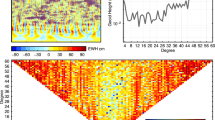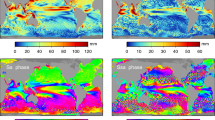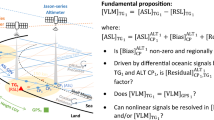Abstract
For science applications of the gravity recovery and climate experiment (GRACE) monthly solutions, the GRACE estimates of \(C_{20}\) (or \(J_{2}\)) are typically replaced by the value determined from satellite laser ranging (SLR) due to an unexpectedly strong, clearly non-geophysical, variation at a period of \(\sim \)160 days. This signal has sometimes been referred to as a tide-like variation since the period is close to the perturbation period on the GRACE orbits due to the spherical harmonic coefficient pair \(C_{22}/S_{22}\) of S2 ocean tide. Errors in the S2 tide model used in GRACE data processing could produce a significant perturbation to the GRACE orbits, but it cannot contribute to the \(\sim \)160-day signal appearing in \(C_{20}\). Since the dominant contribution to the GRACE estimate of \(C_{20}\) is from the global positioning system tracking data, a time series of 138 monthly solutions up to degree and order 10 (\(10\times 10\)) were derived along with estimates of ocean tide parameters up to degree 6 for eight major tides. The results show that the \(\sim \)160-day signal remains in the \(C_{20}\) time series. Consequently, the anomalous signal in GRACE \(C_{20}\) cannot be attributed to aliasing from the errors in the S2 tide. A preliminary analysis of the cross-track forces acting on GRACE and the cross-track component of the accelerometer data suggests that a temperature-dependent systematic error in the accelerometer data could be a cause. Because a wide variety of science applications relies on the replacement values for \(C_{20}\), it is essential that the SLR estimates are as reliable as possible. An ongoing concern has been the influence of higher degree even zonal terms on the SLR estimates of \(C_{20}\), since only \(C_{20}\) and \(C_{40}\) are currently estimated. To investigate whether a better separation between \(C_{20}\) and the higher-degree terms could be achieved, several combinations of additional SLR satellites were investigated. In addition, a series of monthly gravity field solutions (\(60\times 60\)) were estimated from a combination of GRACE and SLR data. The results indicate that the combination of GRACE and SLR data might benefit the resonant orders in the GRACE-derived gravity fields, but it appears to degrade the recovery of the \(C_{20}\) variations. In fact, the results suggest that the poorer recovery of \(C_{40}\) by GRACE, where the annual variation is significantly underestimated, may be affecting the estimates of \(C_{20}\). Consequently, it appears appropriate to continue using the SLR-based estimates of \(C_{20}\), and possibly also \(C_{40}\), to augment the existing GRACE mission.











Similar content being viewed by others
Notes
While a \(5\times 5\) gravity field was originally estimated for TN07, it was found that estimating only the 2,1 and 4,1 terms was providing an inadequate number of degrees of freedom, and the estimate of \(C_{21}\) in particular was being skewed. Adding the 6,1 terms reconciled the SLR estimates with GRACE, and this extra set of terms is now routinely included.
References
Albertella A, Migliaccio F, Sanso F (1991) The Aliasing effects in the coefficients estimation. In: Determination of the geoid present and future. IAG symposioum no. 106, pp 10–15
Bettadpur S (2012) UTCSR level-2 processing standards document GRACE 327-742. ftp://podaac.jpl.nasa.gov/allData/grace/docs/L2-CSR0005_ProcStd_v4.0.pdf
Bloßfeld M, Muller H, Gerstil M, Štefka V, Bouman J, Göttl F, Horwath M (2015) Second degree Stokes coefficients from multi-satellite SLR. J Geod 89:857–871. doi:10.1007/s00190-015-0819-z
Chen JL, Wilson CR, Seo KW (2009) S2 tide aliasing in GRACE time-variable gravity solutions. J Geod. doi:10.1007/s00190-008-0282-1
Cheng MK, Eanes RJ, Shum CK, Schutz BE, Tapley BD (1989) Temporal variation in low degree zonal harmonics from Starlette orbit analysis. Geophys Res Lett 16(5):393–396
Cheng MK, Tapley BD, Casotto S (1995) A new method for computing the spectrum of the gravitational perturbations on satellite orbits. Celest Mech Dyn Astron 62:117–143
Cheng MK, Shum CK, Tapley BD (1997) Determination of the long-term changes in the Earth’s gravity field from satellite laser ranging observation. J Geophys Res 102(B10):22377–22390
Cheng MK (2002) Gravitational perturbation theory for intersatellite tracking. J Geod 76:169–185. doi:10.1007/s00190-001-0233-6
Cheng MK, Tapley BD (2004) Variations in the Earth’s oblateness during the past 28 years. J Geophys Res 109: B09402. doi:10.1029/2004JB003028
Cheng MK, Tapley BD, Bettadpur S, Ries J (2008) Determination of thermospheric winds from GRACE accelerometer data. In: 18th AAS/AIAA space flight mechanics meeting, Galveston, Texas, January 27–31, no. AAS-08-176
Cheng MK, Tapley BD, Ries JC (2013) Deceleration in the Earth’s oblateness. J Geophys Res 118:1–8. doi:10.1002/jgrb.50058
Cheng MK, Ries JC (2015) Evaluation of GOCE gravity models with SLR orbit tests. Newton’s Bull 5. Assessment of GOCE geopotential models, June 2015, pp 187–192, ISSN 1810-8555
Cheng MK, Ries JC (2016) GRACE technical note #07: monthly estimates of C20 from 5 satellites based on GRACE RL05 models. http://podaac.jpl.nasa.gov/gravity/grace-documentation
Eanes R (1995) A study of temporal variations in Earth’s gravitational field using LAGEOS-1 laser range observations. The University of Texas at Austin Center for space research report CSR-95-8
Flechtner F (2007) AOD1B product description document for product release 05. GRACE Project Document 327-750. http://www.gfz-potsdam.de/en/aod1b/
Flury J, Bettadpur S, Tapley BD (2008) Precise accelerometer onboard the GRACE gravity field satellite mission. Adv Space Res 42:1414–1423. doi:10.1016/j.asr.2008.05.0004
Gooding RH (1971) Lumped fifteenth-order harmonics in the geopotential. Nature 231:168–169. doi:10.1038/physci231168a0
Han S-C, Jekeli Ch, Shum CK (2004) Time-variable aliasing effects of ocean tides, atmosphere, and continental water mass on monthly mean GRACE gravity field. J Geophys Res 109. doi:10.1029/2003JB002501
Kaula W (1966) Theory of satellite geodesy. Blaisdell, Waltham
King-Hele D (1964) Theory of satellite orbits in an atmosphere. Butterworths, London
Klinger B, Mayer-Gürr T (2016) The role of accelerometer data calibration within GRACE gravity field recovery: results from ITSG-Grace2016. Adv Space Res 58:1597–1609
Knudsen P, Andersen O (2002) Correcting GRACE gravity fields for ocean tide effects. Geophys Res Lett 29(8):1178. doi:10.1029/2001GL014005
Lambeck K (1980) The Earth’s variable rotation: geophysical causes and consequences. Cambridge University Press, Cambridge
Lyard F, Lefevre F, Letellier T, Francis O (2006) Modeling the global ocean tides: modern insights from FES2004. Ocean Dyn 56(5):394–415. doi:10.1007/s10236-006-0086-x
Mayer-Gürr T, Behzadpour S, Ellmer M, Kvas A, Klinger B, Zehentner N (2016) ITSG-Grace2016—monthly and daily gravity field solutions from GRACE. GFZ data services. http://doi.org/10.5880/icgem.2016.007
Meyrath T, van Dam T, Weigelt M, Cheng M (2013) An assessment of degree-2 Stokes coefficients from Earth rotation data. Geophys J Int 195:249–259. doi:10.1093/gji/ggt263
Meyrath T, Rebischung P, van Dam T (2016) GRACE era variability in the Earth’s oblateness: a comparison of estimates from six different sources. Geophys J Int. doi:10.1093/gji/ggw441
Moore P, King MA (2008) Antarctic ice mass balance estimates from GRACE: tidal aliasing effects. J Geophys Res 113:F02005. doi:10.1029/2007JF000871
Nyquist H (1928) Certain topics in telegraph transmission theory. Trans AIEE 47:617–644
Petit G, Luzum B (2010) IERS technical note no. 36, IERS Conventions, (2010), International Earth Rotation and Reference Systems Service. Frankfurt, Germany
Peterseim N, Flury J, Schlicht A (2012) Magnetic torque induced disturbing signals within GRACE accelerometer data. Adv Space Res 49:1388–1394
Ray RD (1999) A global ocean tide model from TOPEX/POSEIDON altimetry: GOT99.2. NASA Technical Memorandum 209478
Ray RD, Luthcke SB (2006) Tide model errors and GRACE gravimetry: towards a more realistic assessment. Geophys J Int 167:1055–1059. doi:10.1111/j.1365-246X.2006.03229.x
Ray RD, Loomis B, Luthcke SB (2015) Ocean tide solution from GRACE range-rate data, presented at 2015 GRACE science meeting, Austin, 21–23 September 2015. http://www.csr.utexas.edu/grace/GSTM/2015/proceedings.html
Ries JC, Shum CK, Tapley BD (1993) Surface force modeling for precision orbit determination. Environ Eff Spacecr Position Traject Geophys Monogr 73, IUGG vol, 13
Rodell M, Houser PR, Jambor U, Gottschalck J, Mitchell K, Meng C-J, Arsenault K, Cosgrove B, Radakovich J, Bosilovich M, Entin JK, Walker JP, Lohmann D, Toll D (2004) The global land data assimilation system. Bull Am Meteorol Soc 85(3):381–394
Schutz BE, Cheng MK, Eanes RJ, Shum CK, Tapley BD (1993) Geodynamic results from Starlette orbit analysis. In: Smith DE, Turcotte DL (eds) Contributions of space geodesy to geodynamics: Earth dynamics. Geodyn Ser 24:175–190. AGU Washington, DC
Seo K-W, Wilson CR, Han SC, Waliser DE (2008) Gravity recovery and climate experment (GRACE) alias error from ocean tides. J Geophys Res 113. doi:10.1029/2006JB004747
Shannon CE (1949) Communication in the presence of noise. Proc Inst Radio Eng 37(1):10–21
Sośnica K, Jäggi A, Meyer U, Thaller D, Beutler G, Arnold D, Dach R (2015) Time variable Earth’s gravity field from SLR satellites. J Geod 89:945–960. doi:10.1007/s00190-015-0825-1
Sun Y, Ditmar P, Riva R (2016) Observed changes in the Earth’s dynamic oblateness from GRACE data and geophysical models. J Geod 90:81–89. doi:10.1007/s00190-015-0852-y
Tapley BD, Schutz BE, Born GH (2004) Statistical orbit determination. Elsevier Academic Press, Amsterdam
Tapley BD, Schutz BE, Eanes RJ, Ries JC, Watkins MM (1993) Lageos laser ranging contributions to geodesy, and orbit dynamics. In: Smith DE, Turcotte DL (eds) Contributions of space geodesy to geodynamics: Earth dynamics. Geodyn Ser 24:147–173, AGU Washington, DC
Tapley BD, Ries JC, Davis GW, Eanes RJ, Schutz BE, Shum CK, Watkins MM, Marshall JA, Nerem RS, Putney BH, Klosko SM, Luthcke SB, Pavlis D, Williamson RG, Zelensky NP (1994) Precision orbit determination for TOPEX/POSEIDON. J Geophys Res 99(C12):24383–24404
van den Dool H, Huang J, Fan Y (2003) Performance and analysis of the constructed analogue method applied to US soil moisture applied over 1981–2001. J Geophys Res 108:1–16
Yuan DN (1991) The determination and error assessment of the Earth’s gravity field model. The University of Texas at Austin, Center for space research report CSR-91-1
Acknowledgements
This research was supported in NASA Grants NNX16AF20G, NNX12AK13G and JPL 1479726. The insightful comments from 4 anonymous reviewers are greatly appreciated. The authors acknowledge the help of Dr. Steve Poole and Peter Nagel. We thank the International Laser Ranging Service for making the SLR data available for this study and the Texas Advanced Computing Center for providing computational resources.
Author information
Authors and Affiliations
Corresponding author
Rights and permissions
About this article
Cite this article
Cheng, M., Ries, J. The unexpected signal in GRACE estimates of \(C_{20}\) . J Geod 91, 897–914 (2017). https://doi.org/10.1007/s00190-016-0995-5
Received:
Accepted:
Published:
Issue Date:
DOI: https://doi.org/10.1007/s00190-016-0995-5




